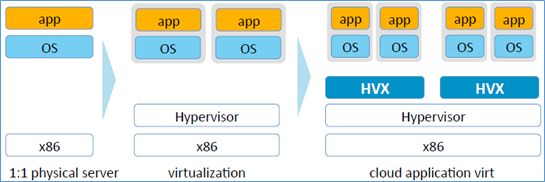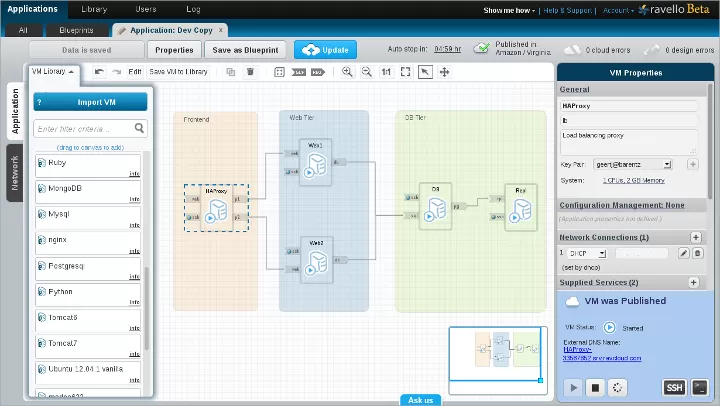 The cloud market is young, despite AWS’ growth and current worth of a few billion dollars. Most of the enterprise’s IT resources are still hosted on the organizational premise of using VMware hypervisor. The enterprise hybrid cloud challenge is hidden in the cloud utility model’s basic notion of hardware as software, whereas legacy application performance and usages are still based on physical resources capabilities. This difference is the greatest factor when it comes to discussing the evolution pace of the `enterprise grade cloud`. The CIO today is required to show cloud adoption and IT operations’ efficiency. This is consequentially triggering new startups to evolve in efforts to facilitate IT resources to close this existing gap. What follows is a story of such a startup that, in my opinion, has a real chance at becoming a leader in this intermediary cloud adoption phase and the hybrid cloud ultimate enabler, Ravello Systems.
The cloud market is young, despite AWS’ growth and current worth of a few billion dollars. Most of the enterprise’s IT resources are still hosted on the organizational premise of using VMware hypervisor. The enterprise hybrid cloud challenge is hidden in the cloud utility model’s basic notion of hardware as software, whereas legacy application performance and usages are still based on physical resources capabilities. This difference is the greatest factor when it comes to discussing the evolution pace of the `enterprise grade cloud`. The CIO today is required to show cloud adoption and IT operations’ efficiency. This is consequentially triggering new startups to evolve in efforts to facilitate IT resources to close this existing gap. What follows is a story of such a startup that, in my opinion, has a real chance at becoming a leader in this intermediary cloud adoption phase and the hybrid cloud ultimate enabler, Ravello Systems.
What’s MVNO? A Mobile Virtual Network Operator (MVNO) (or mobile other licensed operator (MOLO) in the United Kingdom) is a wireless communication service provider that does not own the wireless network infrastructure to which the MVNO provides services. https://en.wikipedia.org/wiki/MVNO
Ravello,The Cloud Application Hypervisor
Behind Ravello are the people who created the KVM hypervisor so it was only natural for them to come with what they call the `Cloud Application Hypervisor`. The Ravello hypervisor oversees cloud virtualization and allows IT users to encapsulate their application’s collection of IT resources including computing, networking and storage. The resulting Ravello application capsule is agnostic to the cloud/IT environment it runs on. Today, Ravello’s users can upload their VMware images, define and sketch the network topology, and in as fast as a click, run it on AWS cloud, HP cloud or Rackspace. This capability is pretty impressive when you consider that they can support a migration* of any windows version, checkpoint firewalls, shared storage, big IP and even the mac addresses. That being said, Ravello targets the large enterprise.
*Ravello team doesn’t like to describe their platform capability as `migration` since it is not a one-time kind of move but more of a dynamic between hosting/cloud environments.

Ravello’s offer is composed of the following three components:
- HVX – A nested hypervisor which is the engine behind Ravello’s ability to normalize an application environment across private and public clouds.
- IO Overlay / Software Defined Network– Defines any custom networking and storage topology for your application.
- Application Framework – Manages your multi-VM application as one self-contained object.
Once you upload your VMware images, Ravello then runs a “cloud fit” scan to find which cloud environment they best suit. The “best fit” algorithm takes in mind best performance and/or costs. The system can also run an optimization action, such as resource consolidation, in order to enhance the cloud running costs. The core capabilities as well as the challenges of Ravello’s technology are hidden in its ability to present this second virtualization layer without harming performance (sometimes even out preform the IaaS vendor itself), while enabling an as-is replica of the on-premise application.

Enabling the Hybrid Cloud
The debate around the private cloud is still a valid one, however the reality is that AWS works towards building a private cloud for the CIA as opposed to the famous Amazon CT, Mr Vogles, who made a point of acknowledging, in the last re:Invent show (2011), that the private cloud does not exist. This is not only the case with AWS, but with Google as well. At a Google Cloud conference, I asked Greg DeMichillie, Google Cloud Director of Product, about the GCE private cloud road map, and unsurprisingly, he noted that the Private cloud is not even on Google’s radar.
In fact, the private cloud is a means that serves a hybrid strategy that has been perceived as the most balanced and realistic approach thus far. The hybrid strategy is driven by several factors such as eliminating uncontrolled costs and usage risks as well as issues like data security and regulations. Some would say that Zynga is the sole enabler of a hybrid solution, however I think that running efficient development and test operations should also be taken into consideration. Using the public for development and testing purposes is also the natural transitional phase that an IT organization can use in order to apply and advance its cloud skills and production deployment.
A few weeks ago, I had an interesting discussion with the Ravello’s CEO and Co-founder, Rami Tamir. According to Tamir, the idea of Ravello came from the basic reality that everyone has some experience using the public cloud, however the cost of moving and maintaining an existing application back and forth from the enterprise on-premise and the cloud is around three times the cost on-premise (some would even say four or more), resulting in the need for a hybrid strategy.
“The traditional veteran enterprise already knows its applications’ workloads and usage patterns – the average… what we at Ravello call the “IT DC”. The IT leader of the organization understands today that the public cloud can perform well in cases of bursts and unpredictable demand. However, can you really get the exact same performance on the cloud infrastructure? Moreover, if you start a project in the cloud, chances are it will continue to reside in the cloud. So the basic truth is that creating this “hybrid cloud” is not so straight forward. “ Tamir said.
Although Tamir mentioned it as a `pet project`, I find it important to note that the Ravello developers have already demonstrated how their core capabilities can support the automation needed in a multi-cloud deployment.
In the picture above are Ravello’s Co-Founders – Rami Tamir, CEO (on the right) and Benny Schnaider, President and Chairman of the Board.
Dev, Test and a Cloud Broker
Ravello founders decided to focus their go-to market efforts on “non-production environments” (i.e. development and testing). More than three years ago, lab managers and internal enterprise IT were quite possibly the first to see a bottom up adoption of the public cloud by their lab and QA teams. This adoption was driven by the cloud’s agility that eliminates the time consuming tasks of setting up and tearing down test environments. According to Tamir these are the “typical enterprise bursts” that account for 60% of all enterprise data center workloads. That actually makes sense when it comes to a pure R&D unit that spend most of its resources on the ongoing cycles of release, while generating multiple replicas of their applications.
The typical Ravello user is an early-adopter developer and tester that needs to quickly replicate an application stack in order to focus on the product building phase. The challenge that stands in the developer’s way is making sure that the replica of the on-premise application is the exact same within the public cloud. That is the challenge hidden within the on-premise features versus the new IaaS environment, such as multicast protocols, complex clustering or NAS (check out my Enterprise Grade Cloud Enabled by the Ecosystem) that probably won’t be supported by the public cloud vendors very soon.
Using the public for testing and development is just the preliminary step to hybrid cloud deployment. The hybrid cloud cost model can be achieved when automation of the operation takes place, hence auto-scaling out to the public cloud and auto-moving of cloud workloads “back home“.
“We are the MVNO of Cloud…” Rami Tamir, CEO at Ravelllo Systems
Aiming to close this gap, Ravello holds a very interesting position in the cloud value chain, standing between the IaaS vendor and its most valuable customer, the large enterprise. Purely acting as a cloud broker, Ravello is an authorized biller for IaaS vendors, and with its added values, the company’s platform has the capabilities of becoming a marketplace for trading IT resources in the future.This valuable cloud broker position today is mostly occupied by the MSP/Integrator that enables the cloud using the ordinary, traditional and professional IT service methods. Even Rightscale, one of the cloud leading management vendors, which aimed to deliver a pure SaaS solution for cloud management ended up generating most of its revenues from professional services.
As a SaaS enthusiast, I was long awaiting a real SaaS vendor that could fulfill this gap with actual online software as a service product. From my discussion with Tamir I hope that their current vision and strategy will not change.
My Outlook
In a discussion with Gil Hoffer, Ravello’s head of R&D, he continually used the term “devices” to describe Ravello’s platform. He also used the notion of building “Virtual Hardware” while maintaining the IT known perception and language. These factors made it clear that virtualization and cloud services are fundamental elements of Ravello’s core capabilities and DNA. With that said Ravello can even position itself as the `virtual data center creator`.
The new cloud broker will need to give broad added pure cloud values starting from the basic auto scale after moving to the public cloud. That will help an enterprise `encapsulate` its application while aligning capacity to demand and really take advantage of the public cloud. This type of feature will be a sure way of making Ravello a leader in the hybrid cloud evolving market within the cloud arena.
The perception of application/service encapsulation is important when becoming a player in building the enterprise applications’ portfolio directory, in conjunction with running optimized cloud operations underneath. Ravello should also take its `pet project` seriously in order to deliver a real `cloud agnostic` platform. One point of the conversation with Tamir about the possibility of a purely public cloud future ended (like with some other experienced executives in the market) with an agreement that it is a valid option and it is only a matter of how much time it can take. Tamir recognizes the fact that there are applications that were built to be in the cloud and that will never move back on-premise. This is a crucial point for Ravello that, not so long from now, will might need to confront the `Netflix Cloud Scenario` of living exclusively in the public cloud.
Ravello Systems Announcing General Availability of Its Cloud Application Hypervisor
On February this year Ravello closed its second funding round bringing the total amount of funds raised to $26 million. Ravello is backed by Sequoia Capital, Norwest Venture Partners and Bessemer Venture Partners. Today Ravello announced the General Availability of their application hypervisor.
Prices are usage based. Ravello’s service new prices start as low as $0.14/hour for 2vCPU and 4GB RAM for application compute, and include the cost of the underlying public cloud.
The actual price point depends on 3 factors:
- Size of the application
- Complexity of the application (‘advanced’ tier = basic networking, ‘enterprise’ tier = complex networking)
- Optimization criteria (cost optimized or performance optimized).
